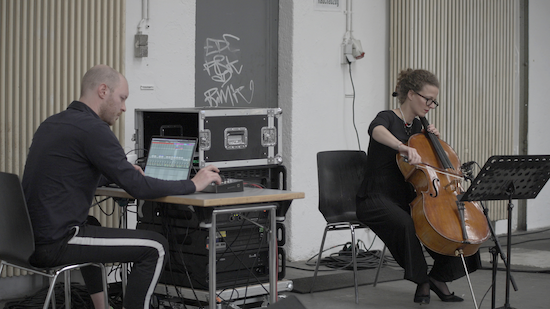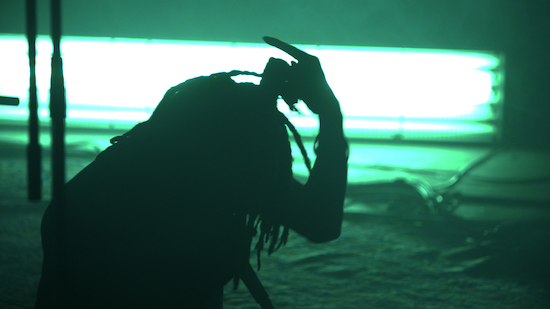Duma. Photos by Mathias Reitz Zausinger and Tizian Stromp Zargari
At ZIRKA, a former military complex turned cultural hub in Munich, Kenyan duo Duma make the case that artists specialising in grindcore-tinted, gabber influenced metal are well equipped to convey the horror of biodiversity freefall. Commissioned by Fragments Of Sonic Extinction to create a piece addressing the dwindling of natural sounds in the earth’s biosphere, Duma delivered ‘Black Rhinos (shot to extinction for their horns)’, a composition which is available online. Elements of it appear in their set at the project’s showcase event.
‘Black Rhinos (shot to extinction for their horns)’ evokes the scene of a crime, laden with gun shots, animal cries and harrowing machine whines. Distinct from the pummelling charge of Duma’s other recordings, it nevertheless replicates their intensity. At the showcase, the piece blends into tracks from their 2020 eponymous debut album. Live, as on record, those songs hack brutality into positivity. They rewire violent sonics into ecstatic energy. In the context of Fragments Of Sonic Extinction, their music becomes a projection of terror and solidarity, eulogy and protest in one. Noise can do many things, in Duma’s hands, it rebukes a world that can facilitate the horrendous under the guise of normality.
A 2019 UN report claims a million species of plants and wildlife face extinction, "many within decades." That’s an overwhelming number, and the repercussions of these absurd mathematics are impossible to fully comprehend. In such a situation, can art really make a difference? Fragments Of Sonic Extinction’s strength lies in making graspable the narratives underneath the bewildering numbers.
The project was instigated by Munich-based artist and curator Kalas Liebfried and in this iteration is co-curated with Canadian artist L M Ramsey. Its second year marks its expansion from a virtual archive into an accompanying live event. The showcase spreads across two rooms, one hosting installations, the other live performances. Some pieces interrogate human culpability. Examinations of inter-species ethics, how right from wrong is decided and the effects these decisions have. Mishka Henner’s ‘Nature Calls’ fills the exhibition room with distressed animal sounds, mimics by human hunters to lure prey. It paints a despairing picture of a world where humans are left firing the cries of dead animals into a hollow vortex.
Like the recording, the live performance of Beni Brachtel’s ‘Overbreeding’ ruminates on selective breeding of French bulldog populations. Zoé Karlikow’s cello-playing gets captured and warped through Brachtel’s processing. Earlier gestures remerge in disjointed forms and rasping glissandos, creating a potent evocation of generationally accumulated respiratory difficulty. Ethical questions are made tangible through mangled plucks and bows.
Prague-based artist Aloïs Yang explores the perception of change. He begins distributing lumps of charcoal around the room and to the audience while blowing small melodies on a traditional Taiwanese nose trumpet. Once we’ve acclimatised to the fact a performance has subtly begun, we move to the main venue room where Yang diffuses a web of glistening rhythms. In the moment I imagine these sounds are drips hitting a metallic surface, but later learn they’re actually a recording of an ice block melting in a ring of fire. What starts vibrant becomes harsh, brittle, parched. Partly the progression of the process documented, partly through Yang’s electronic manipulations. The opening ritual and the sonic performance seem linked by a call to notice – the slow moving, elemental changes in our surroundings and the traditions embedded within precariously balanced ecosystems.

Beni Brachtel and Zoé Karlikow
Another thread running through Fragments Of Sonic Extinction is exploring human impacts from a non-human perspective. A strive for empathy beyond capturing other creatures’ calls. ‘Junk Anima’, Liebfried and Ramsey’s track as Dawn Phase, uses hydrophone recordings of maritime noise to conjure the cacophony bombarding marine wildlife as shipping increases. (The titular ‘junk’ refers to the structure in a whale’s forehead which was dismissed as worthless by whalers but is in fact crucial to communication and echolocation). Liebfried’s live set of levitating drones somewhere between Emeralds and Sunn 0))) is quite different. Midway through, an uncanny vocalisation enters. The loop comes from Ramsey’s work mapping wolf sounds to language. Coming through Liebfried’s growling guitar and synth, it speaks to closeness and difference, questioning where inter-species connection might be found.
The decline of bees is one of the most recognised environmental catastrophes, probably because it has clear existential ramifications for humanity. Heloise Tunstall-Behrens and Auclair approach it theatrically with their recording ‘Dance Off (acapella)’. The form of their overlapping voices aims to reflect bee colonies – a polyphony that works in unison. The lyrics dramatise Apoidea migration into a rousing epic quest: "Go far away, go far away, hollow tree." The work reaches for inter-species understanding. In doing so, they paint a narrative that’s more poignant than stats on population decline.
Fragments Of Sonic Extinction’s power comes in moving beyond disorientating statistics to focus on the stories threading through them. Recognising sound can make the immense tangible, by opening the project to everyone from grindcore artists to choir composers new levels of insight break through. To paraphrase and slightly misuse a Donna Haraway book title, the project stays with the trouble. By exploring the complex stories and ethical failures weaving through species decline, it also offers tentative hints of where interventions might be possible.
The recordings commissioned for Fragments Of Sonic Extinction can be heard here.


